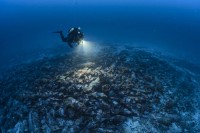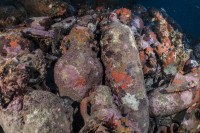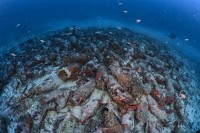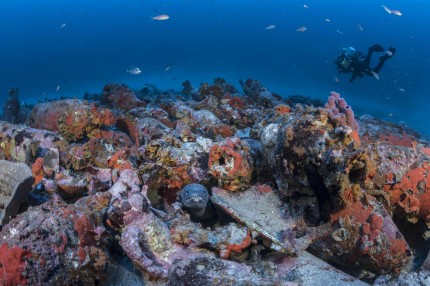 A Roman shipwreck from the 3rd or 4th century A.D. has been discovered next to the island of Cabrera just south of Mallorca, Spain. Dubbed Cabrera XIV, the wreck is in untouched condition, preserved where it fell for almost 2000 years. Archaeologists Sebastià Munar and Javier Rodríguez Pandozi of the Balearic Institute of Studies in Marine Archeology (IBEAM) describe the find as “the best preserved wreck of the Balearic Islands and, most likely, one of the best preserved in the western Mediterranean.”
A Roman shipwreck from the 3rd or 4th century A.D. has been discovered next to the island of Cabrera just south of Mallorca, Spain. Dubbed Cabrera XIV, the wreck is in untouched condition, preserved where it fell for almost 2000 years. Archaeologists Sebastià Munar and Javier Rodríguez Pandozi of the Balearic Institute of Studies in Marine Archeology (IBEAM) describe the find as “the best preserved wreck of the Balearic Islands and, most likely, one of the best preserved in the western Mediterranean.”
“As far as we know, this is the first time that a completely unaltered wreck has been found in Spanish waters,” says Javier Rodríguez, one of the marine archeologists who participated in the exploration and documentation of the remains of the ship, describing it as an “architectural jewel.”
The difficult-to-reach location and the fact the waters are part of a National Park have been key factors in the preservation of the vessel.
 The ship was found in waters 70 meters (230 feet) deep in April 2016 after fishermen reporting pulling up some amphora fragments in their nets at that location. IBEAM scouted the site with a robot. The robot’s images revealed a vast mound of amphorae covering 50 feet of the seabed. In October, human divers dove the site, exploring and photographing in greater detail and at the level of the wreck itself. They took more than 2,000 pictures of the site from all angles which allowed experts to determine its size and orientation.
The ship was found in waters 70 meters (230 feet) deep in April 2016 after fishermen reporting pulling up some amphora fragments in their nets at that location. IBEAM scouted the site with a robot. The robot’s images revealed a vast mound of amphorae covering 50 feet of the seabed. In October, human divers dove the site, exploring and photographing in greater detail and at the level of the wreck itself. They took more than 2,000 pictures of the site from all angles which allowed experts to determine its size and orientation.
The ship was 20 meters (65 feet) long and carried a cargo of between 1,000 and 2,000 amphorae. Most of them were made in North Africa and are about one meter (3.3 feet) high. The rest were smaller and made in the south of the Iberian peninsula. Both types of jars carried garum, the sauce made from fermented fish intestines that the Romans put on everything.
 Archaeologists believe the ship was transporting garum along a trade route between North Africa and Spain with stops in Gaul and Rome. When the ship sank in antiquity, it capsized on the sea floor. The amphora field covered the ship’s hull, preserving it as an oval mound about 15 meters (50 feet) long and 10 meters (33 feet) wide. With the cargo still in the position it landed in after the wreck, archaeologists are optimistic that there may be surviving timbers from the boat preserved underneath the amphorae.
Archaeologists believe the ship was transporting garum along a trade route between North Africa and Spain with stops in Gaul and Rome. When the ship sank in antiquity, it capsized on the sea floor. The amphora field covered the ship’s hull, preserving it as an oval mound about 15 meters (50 feet) long and 10 meters (33 feet) wide. With the cargo still in the position it landed in after the wreck, archaeologists are optimistic that there may be surviving timbers from the boat preserved underneath the amphorae.
The discovery was kept under wraps until last Friday to keep looters and sightseers from interfering with site. Now that the news is out, the authorities will police and secure the wreck to ensure it is not looted or inadvertently damaged.

😆 😆 😆
Where were Roman ships built? For example, were there enough trees in N Africa to support active shipbuilding there? How long did the average Roman ship last in service?
dearieme- Keep in mind that, even before the Romans, the Carthaginians in N. Africa were a seafaring nation. In addition, N. Africa later became the Roman breadbasket, a significant source of grain. It was not the arid land we are familiar with now.
The ecology now is vastly changed so some wood would have been available there. However, most Roman ships were built on the Roman Peninsula, and most likely by Roman subsidiaries, like the former Greek states. The Romans, themselves, were not truly seafarers. They depended on their clients who maintained those skills.
In cargo shipping, vessels always had a second or even third life. It is probably fair to assume here that, for the transport of rotting fish souce, the ‘swimming stock’ was not always state-of-the-art, even if the Garum itself is said to have been rather pricy. The pirates of the Caribbean, for example, seemed to have preferred slave ships, as those were usually bulky but very fast – plus the cargo.
‘Greeks’ and ‘Punics’ started to play an important seafaring role by around 700 BC. However, ‘Romans’ slowly took over in the western Mediterranean after the Punic Wars. Our wreck is from the 3rd or 4th century AD, but mediterranean wooden ships were made for another millennium. There definitely was a Punic shipbuilding program in Northern Africa, but later flotillas were built (not only) there as well.
Ahoy! :giggle:
I love the caption for the last picture!
Also, do we have recipes for garum? Is it still made?
It looks like a claim has already been made to the site by one of the inhabitants who is looking out at the diversity taking the photo.
I love that eel or whatever it is. Dude, what are you guys doing here? This is my territory. And why do you want all my old jars full of fish guts?
To have real forests in the Mediterranean would be exceptionally cool.
During the Holocene, dwarfed elephants used to live (in forests?) on the Mediterranean islands. Among them, elephas falconeri is an extinct Siculo-Maltese elephant with an adult male specimen measuring 96 cm in shoulder height. Also, the belief in Cyclopes may originate in the nasal cavity of falconeri skulls found in Sicily.
——-
PS: That eel or moray might have not exactly a problem with fish intestines :skull: .
It is not made anymore as recipes are lost except for Apicius mentions, but those lack quantities and timings of process.
Try Vietnamese Nuoc Mam or Thai Nam Pla
Also this is the best net information on it imo: http://www.coquinaria.nl/english/recipes/garum.htm
She does good research.
Vietnamese nuoc mam (Nước Chấm) is SUPPOSED to be a reasonable substitute for garum, but suspect the Roman product was far more pungent. Roman diners were a tough bunch…can’t get my palate “wrapped around” say, dormice dipped in garum. 🙁
The amphorae w/ the muppet fish is now my wallpaper :boogie: